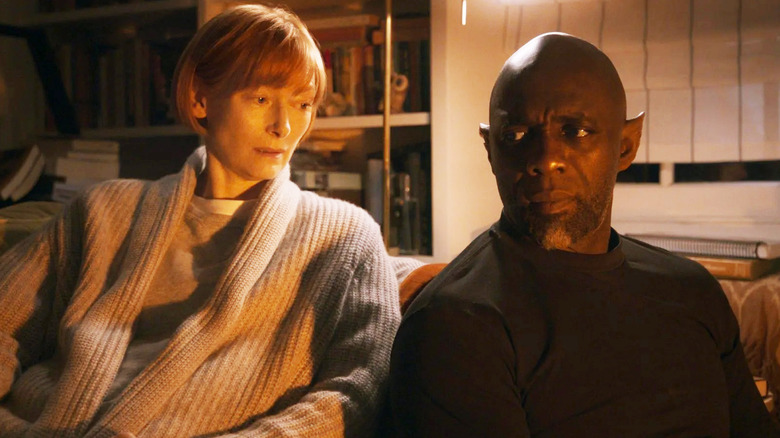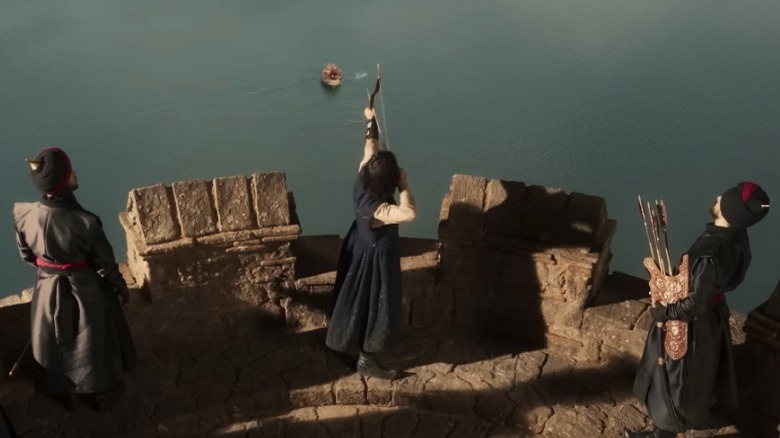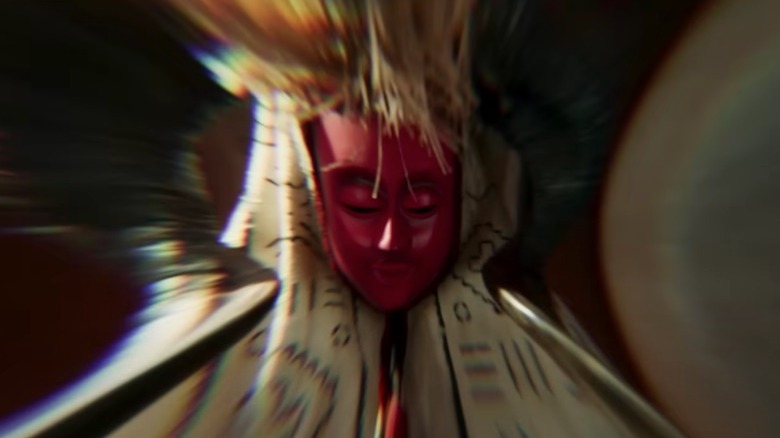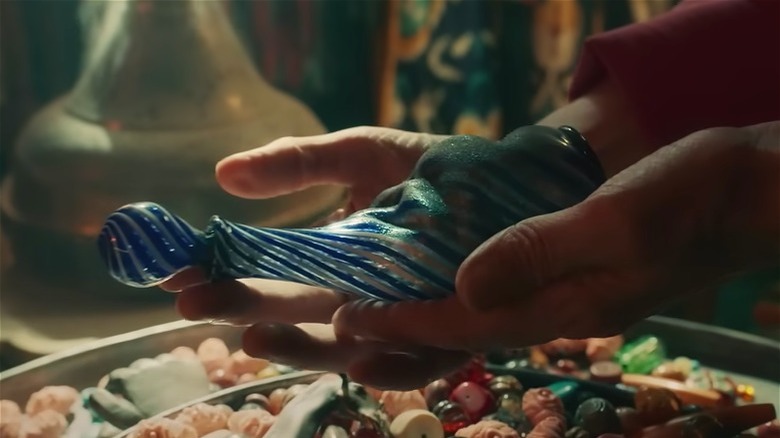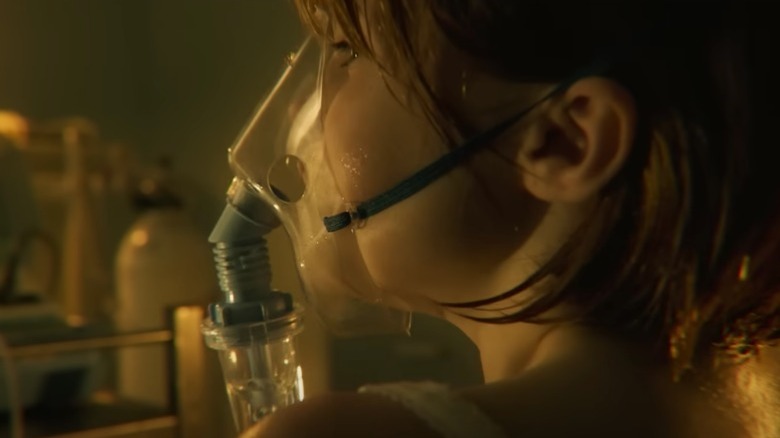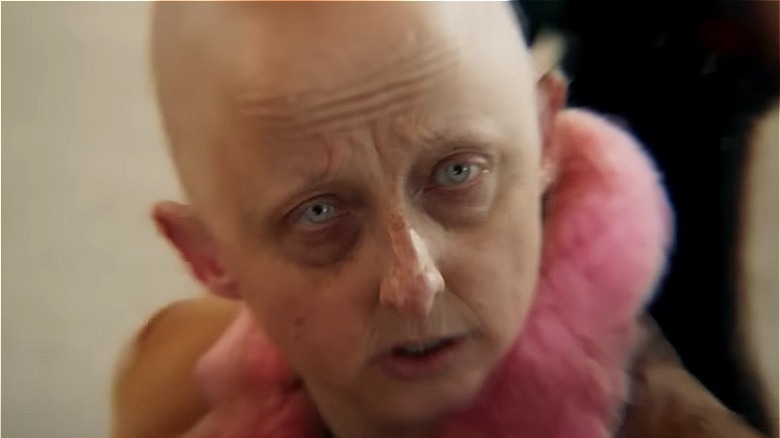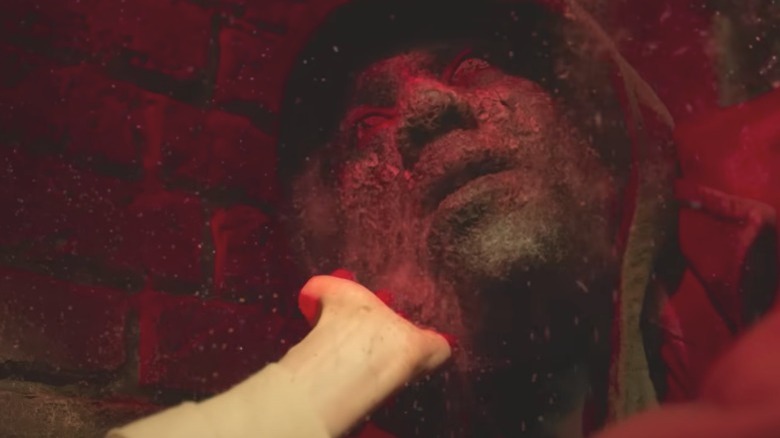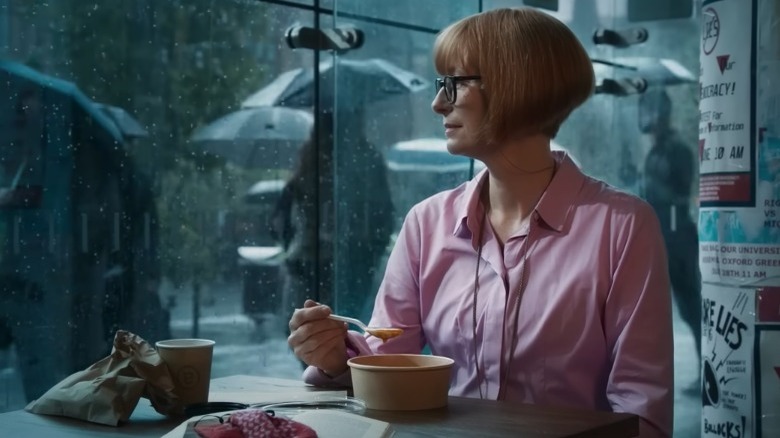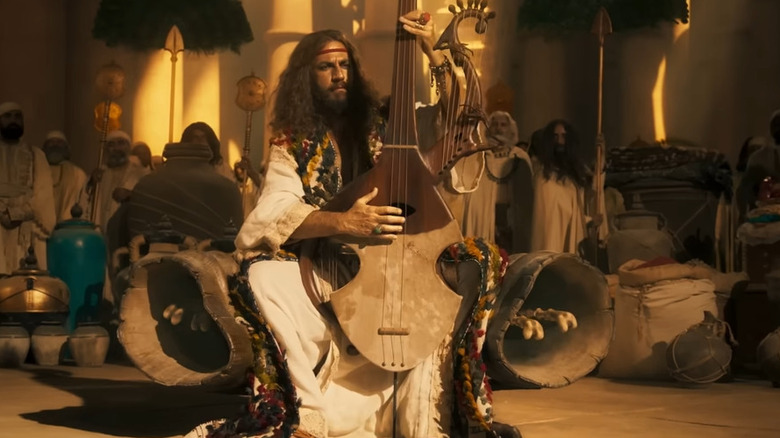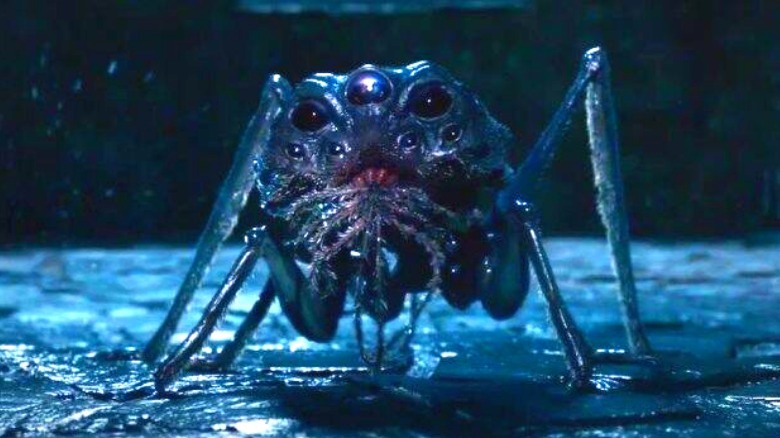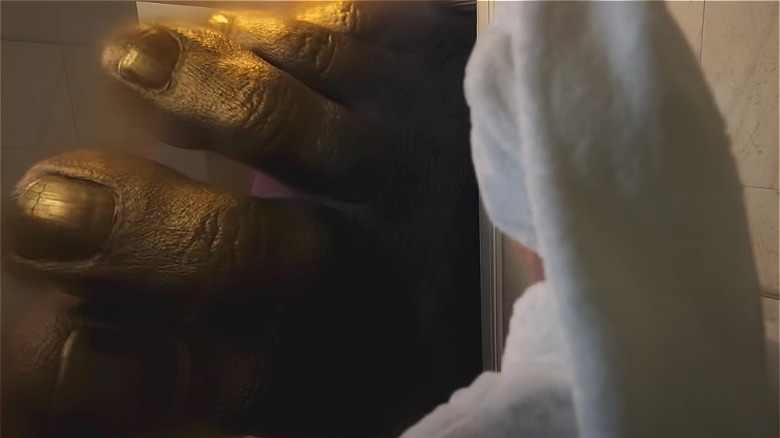The 10 Wildest Moments In George Miller's Three Thousand Years Of Longing, Ranked
Warning: This article contains major spoilers for the movie "Three Thousand Years of Longing."
George Miller is a visionary director with a filmography that can't be confined to one genre. Although known best for "Mad Max: Fury Road," he's also directed the horror comedy "The Witches of Eastwick" and various children's movies, including "Babe: Pig in the City" and both "Happy Feet" films. Miller has demonstrated an ability to delve into the darkest regions of humanity and explore the innocence of childhood imagination. "Three Thousand Years of Longing" combines both of these strengths into one sweeping, visually gorgeous narrative, but don't expect the high-octane action of "Fury Road." As /Film's Rafael Motamayor's review states, the film is "about the importance of storytelling, especially today. It's about how, even if we no longer need to explain the mysteries of the universe through fables, we still use storytelling to explain our emotions and desires."
The main plot centers around Alithea, a narratologist, and her conversation with a Djinn she accidentally releases from a bottle. Djinn is defined by Merriam-Webster as "one of a class of spirits that according to Muslim demonology inhabit the earth, assume various forms, and exercise supernatural power" and, in this case, acts like more a genie. Every story yarn the Djinn spins plays out in sumptuous detail, taking Alithea and the audience on a journey across thousands of years. The massive and fantastical scope of George Miller's "Three Thousand Years of Longing" inspired us to tackle the 10 wildest moments from the film. Get your wishes ready; the Djinn is out of the bottle.
10. Sultan Murad IV kills a storyteller
The Djinn's second tale takes place in the early Ottoman Empire, where a curious young boy grows up to become the bloodthirsty Sultan Murad IV. We get glimpses of his brutal battles and his lack of regard for human life, including his own. His mother tried desperately to curb his lesser impulses by bringing master storytellers to his throne room in hopes of amusing him. One, in particular, does not end well when the Sultan kills a fleeing storyteller with an arrow.
This moment is a darkly comedic juxtaposition. After witnessing the carnage Murad IV is capable of, it's hilariously tragic to watch a storyteller frantically rowing away, then cut to the Sultan calm and emotionless as he lets his bow string loose. The arrow travels hundreds of feet, and the storyteller slumps over in the boat, dead from a ridiculous distance and a remarkably accurate shot. While not the most outlandish moment in the movie compared to the rest of the list, scenes like this add to the movie's fantastical elements and the humor in the tall tales that grow in exaggeration as years and centuries go by.
9. The Djinn is ghosted for 100 years
The Djinn is trapped for over one hundred years after a young woman is killed before she can make her third wish. He is doomed to wander the halls of a palace, attempting to lure anyone to where the bottle is hidden so he can finally be freed. A warped camera angle that distorts the sides of the images and brings the center of the frame into focus serves as our point of view of a wayward Djinn. The camera zooms through halls, past the Sultan's family, lush throne rooms, and in and out of the hidden chambers below.
The entire sequence is haunting. The audience and the Djinn become voyeurs to decades of life passing by, an unseen fly on the wall. There's a particular moment where the camera tracks through the palace halls, past dancing concubines, fierce guards, and the new Sultan, before landing on a dancer wearing a red mask (see above) performing next to a drummer. The camera zooms past them, then circles back and pauses to take it in. The moment might not make the biggest dent in the audience's experience, but it's oddly surreal and beautiful, giving the feeling of how fleeting everything is from the Djinn's perspective. Our lifetimes are but a blip to an immortal genie.
8. A bottle's epic journey
The Djinn was first trapped in a bottle after falling in love with the Queen of Sheba. His fate was sealed when a new suitor, King Soloman, arrived and cast a spell trapping the Djinn in a tiny golden bottle. From there, it's tossed out a castle window, scooped up by a hawk, dropped in the ocean, encased in rock, found in the eye of a soldier's skull, used as a food mashing tool, and finally placed as a stone on a castle wall in the Ottoman Empire. Later, the bottle is accidentally uncovered by a young girl who has fallen in love with the Sultan's son.
This moment beautifully encapsulates the debate between chance and fate. Was all of this meant to happen or was it just random luck? The movie doesn't have a concrete answer. Instead, George Miller decides to take us on a whirlwind journey, allowing us to soak in the imagery as years pass rapidly. The visual effects are heightened just enough to feel like everything we're witnessing lives outside of time in a fantastical reality. So much happens in a few minutes on-screen, and it's a head-spinning trip to take with the Djinn.
7. Alithea's animated friend
Alithea tells the Djinn the story of how, as a child, she went to an all-girls school and didn't fit in. She was often sick from asthma and had no family or friends. To cope with her loneliness, she created an imaginary friend named Enzo, who appeared to her as an animated 2D ink drawing. Her adventures with Enzo filled her with joy and purpose, so she wrote these stories down. The older Alithea got, the sillier this all seemed. She eventually burned all her pages with Enzo, deciding it was time to grow up.
This sequence is not only visually incredible, with the mix of 2D animation and live-action, but it also sums up Alithea's central dilemma and the movie's theme. Is there room for stories in a world of science? Alithea has grown up from a child who believed in the impossible to an adult who dissects narratives and celebrates science over myth. The discovery of the Djinn reminds her that maybe there's more truth to these fantastical stories than her logical mind wants to believe. It's a touching flashback that reminds us of the imagination and innocence of childhood and how that often conflicts with adulthood.
6. A stranger in the airport
Alithea starts her journey in Istanbul. She arrives at the airport and is stopped by what she first assumes is a child, only to reveal it's something supernatural. This being speaks in an ancient language, and its eyes shift colors. They attempt to lead Alithea somewhere, but her friends show up, and the being is gone. In the car, she mentions the being's skin was hot to touch, and they joke maybe it was a Djinn.
This moment marks the first otherworldly event in the movie and sets the stage for the trippy adventure we're about to take with Alithea. Appropriately placed in the middle of our list, it's bizarre, intriguing, a little creepy, and unexplained: All elements the rest of the film will explore. We never fully get an answer as to what this Djinn was doing or why it appeared to Alithea. She later writes moments like these off, saying her imagination gets the better of her. But what if these imaginary creations are actually from her connection to the Djinn world? Perhaps she's more open to the supernatural than her lectures let on?
5. The Djinn gets dusted
Our next wild moment takes us to London. Alithea brings the Djinn back to her home, and the city's electromagnetic energy, noise pollution, and overall chaos are too much for him. He tries to tune it out, but eventually, his corporeal form starts to break down. It escalates to Alithea finding him in the basement, frozen and nearly turned to dust. He's only awoken from this state when she wishes for him to speak.
The reveal of the Djinn's face crumbling and gasping is a haunting image. A spirit that, up until this point, has been so powerful is just wasting away. It seems like this may be the end for our new favorite genie. Alithea warned us at the film's beginning that every story involving wishes is a "cautionary tale." But as the audience buckles up for a tear-jerker ending, Alithea chooses to save the Djinn. She selflessly decides to use her final wish to free him. It's a beautiful end to a long and unlucky chapter in the Djinn's journey, allowing both their stories to continue.
4. An angry spirit appears
Alithea's imaginary or actual spirit sightings escalate during her lecture. Appropriately, she's talking about how myths and Gods were created when humans didn't understand the world and needed stories to guide them. She argues that science solves these mysteries now. The film's message seems to be that humanity needs both stories and science. Alithea sees an angry figure staring at her in the audience. Her anxiety over this encroaching wayward being ends with it opening its mouth to consume her and Alithea falling unconscious.
This moment is incredibly surreal. The spirit looks creepy yet regal. There's no real explanation for who or what this thing is. Alithea even searches the faces of the Gods on the PowerPoint presentation behind her to no avail. Is it her imagination or a Djinn trying to frighten her? We don't find out. This sighting and the Djinn at the airport are just an appetizer for the bizarre imagery that is about to unravel before our eyes. It also showcases the delicate balancing act of comedy, darkness, and the fantastical in store for Alithea from here on out.
3. One-man band seduces the Queen of Sheba
The Djinn's happy love story with the Queen of Sheba is interrupted by King Soloman's arrival as the whackiest one-man band ever put to screen. He plays an upright guitar with another fret that's sentient. It has a face that can whistle, hands to pluck the strings, and bone arms to play the drums. If that wasn't strange enough, Sheba's court includes dozens of mythical creatures, half animal, half human, wraiths, Gods, and mortals.
The fantastical elements in this sequence are on full display, more so than in later tales. This seems purposeful, as if to say before humankind became distracted by science and technology, we were more open to the supernatural, the unexplained (like the half-zebra man standing next to Sheba in this scene). It's a wonderfully bonkers moment, and the only complaint is that we don't get to live in this world longer. There are so many intriguing creatures in the background, and the bizarre duet with the King and his sentient guitar could be its own story. George Miller leaves it up to the audience if all this happened or if the tale became "taller" after a few thousand years.
2. A skin-crawling spider monster
The second from the top of our list is easily the creepiest moment in the entire film. The Djinn is running to save a doomed young woman, only to be stopped by a guard who turns out to be otherworldly. The guard crawls up the tunnel wall as if possessed. His face morphs and his head pops. Slime and a giant talking spider pour out onto the ground. A warning not to interfere is uttered, and the head bursts into thousands of tiny spiders. This scene is nightmare fuel for anyone with arachnophobia.
"Three Thousand Years of Longing" has a lot of bizarre visuals, but none quite like this. What makes it so shocking is that it's entirely unexpected. It also echoes several horror films like "The Exorcist" with unnatural movements and demonic shifts in voice, or "The Thing" with the gooey exploding head and a spider creature whose design is grotesque yet fun. The Djinn and the audience recoils as thousands of spiders crawl by him. It's an incredibly effective and quick gross-out moment.
1. The Djinn is out of the bottle
Our choice for the wildest moment in this film is when Alithea first awakens the Djinn from his latest bottled prison. She uses her electric toothbrush to chip away at the dirt crusted around the top. It bursts open with thick colorful smoke, zipping into the other room. There's a pause, and then a giant gold foot appears. Alithea stares bewildered. The foot disappears in a puff of smoke. Alithea peers around the bathroom door and finds a colossal Djinn taking up her entire hotel living room. His scaled blue legs cramped trying to fit. He eventually shapeshifts into a more manageable height, but his first impression is a big one (pun intended).
This sequence is wild and quite literally opens the floodgates to the otherworldly imagery that follows. Alithea's reaction to a giant foot fumbling on her bathroom door is deadpan perfection. We've all seen a genie exit a bottle in movies before, but this one seems more uncomfortable and less lively than the norm. His initial demeanor seems "over it," and it's only through reliving his tales of woe and connecting with Alithea that they both realize the importance of their own stories. It's a great setup narratively and one of the stand-out visuals in the film.
